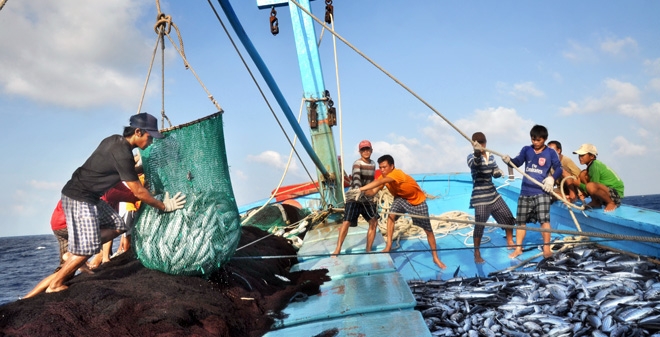Vietnam seafood exports to stay slow in second half
 |
| Vietnam's seafood exports have been affected by the IUU yellow card and COVID-19 |
According to the report “A trade-based analysis of the economic impact of non-compliance with illegal, unreported and unregulated fishing: the case of Vietnam”, issued by Vietnam Association of Seafood Exporters and Producers (VASEP) and the World Bank, seafood exports have been affected by the COVID-19 pandemic while the yellow card from the EU has yet to be removed.
Since May 2021, the COVID-19 pandemic has hit Ho Chi Minh City and the Mekong Delta provinces, affecting production, processing, and export of seafood because of measures such as isolation and social distancing. Therefore, it is forecast that seafood exports will stay slow over the last six months of 2021.
In the best-case scenario, where the pandemic is reduced and relatively controlled within three months, the monthly growth will only be 6-8 per cent. Seafood exports could reach the target of $9 billion by the end of 2021. In the worst-case scenario, where the pandemic lasts longer and China continues or increases control of frozen seafood imports, exports may only reach approximately $8.8 billion.
The COVID-19 pandemic disrupted global seafood trade in 2020, changing consumption trends in fishery products and reducing demand for seafood imports in most markets. The main importers of Vietnamese seafood such as the EU, China, South Korea, and Japan all slightly decreased imports from Vietnam (by 3-6 per cent).
Regarding the yellow card from the EU, Vietnam has been rolling out efforts to reign in IUU fishing since 2017. Government agencies and the entire Vietnamese fishing community have been striving to meet the recommendations of the EU and remove the yellow card. However, while the EU has lauded Vietnam’s efforts, it has not removed the yellow card yet.
The EU is a very important trade partner for Vietnam and a major importer of its fish products, including seafood. Vietnam’s seafood exports to the EU have increased sharply over the past 20 years, from $90 million in 1999 to nearly $1.5 billion in 2017 (and since decreased to $1.3 billion in 2019).
Between 2017 and 2019, since the yellow card was awarded, the value of seafood exports to the EU declined by 12 per cent or $183.3 million. Total marine product exports have decreased by over 10 per cent, equivalent to $43 million in value. Of these, cephalopod plunged the most with 37 per cent, bivalve mollusks decreased 11 per cent, tuna decreased by nearly 2 per cent, and crabs decreased by 11 per cent. The exports of farmed products to the EU also decreased by 13 per cent from 2017 to 2019.
This downward trend is expected to continue in 2021, especially in the context of the COVID-19 pandemic, which has affected Vietnam’s fishing activities as well as the catch certification of seafood exported to the EU.
Since 2018, the EU has dropped from being its the second-largest importer of Vietnamese seafood to fifth place, now ranking behind Japan, the US, South Korea, and ASEAN. The EU's share of Vietnam’s total marine product exports dropped from 15 to 11.6 per cent from 2017 to 2019.
In 2020, Vietnam’s seafood exports to the EU were also affected by COVID-19, resulting in a turnover of only $959 million, a decrease of 5.7 per cent compared to 2019. The UK leaving the EU in February 2020 also resulted in a decrease in the demand from the EU.
What the stars mean:
★ Poor ★ ★ Promising ★★★ Good ★★★★ Very good ★★★★★ Exceptional
 Tag:
Tag:
Related Contents
Latest News
More News
- Cake by VPBank posts strong gains in scale and efficiency leveraging AI focus (January 05, 2026 | 18:55)
- Vietnam's retail market tops $269 billion in 2025 amid e-commerce boom (December 31, 2025 | 19:00)
- Global alliance develops $1 billion AI data centre network in Vietnam (December 30, 2025 | 10:08)
- Businesses ramp up production as year-end orders surge (December 30, 2025 | 10:05)
- Vietnam’s GDP forecast to grow by 9 per cent in 2026 (December 29, 2025 | 08:29)
- Vietnam's top 500 value-creating enterprises announced (December 27, 2025 | 08:00)
- Three-way partnership unveiled to ease financing at Hong Hac City (December 24, 2025 | 14:13)
- PM orders investment model for North–South high-speed rail (December 22, 2025 | 17:43)
- First members of Danang International Finance Centre revealed (December 22, 2025 | 17:39)
- Securing capital and efficiency for Vietnam’s 2026-2030 growth ambitions (December 17, 2025 | 10:00)























 Mobile Version
Mobile Version